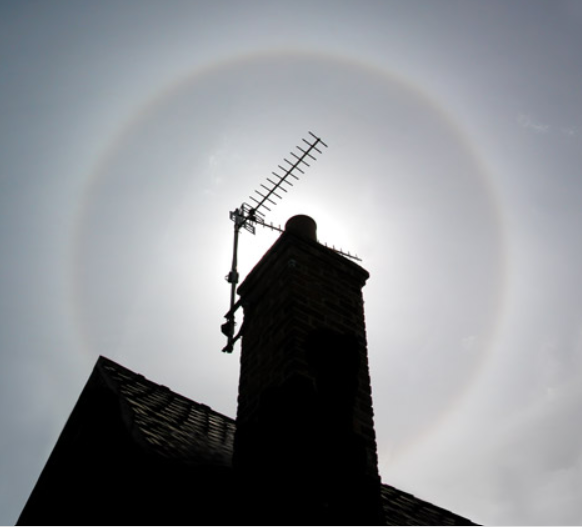22 Degree Halo,22º Halo, 22º Circular Halo
22 Degree Halo: A Mesmerizing Atmospheric Phenomenon
Have you ever looked up at the sky and noticed a stunning circular halo surrounding the sun or the moon? This captivating optical phenomenon is known as the 22-degree halo, 22º halo, or 22º circular halo. Created by millions of ice crystals descending from cirrostratus clouds, this halo is a sight to behold. In this article, we will delve deeper into the fascinating details of the 22-degree halo and explore its characteristics, visibility, and common misconceptions.
Characteristics of the 22-Degree Halo
The 22-degree halo derives its name from its approximate angular diameter of 22 degrees. To visualize this, stretch out your arm and extend your fingers. The span between your thumb and little finger at arm's length is roughly 20 degrees, with the halo extending slightly beyond the little finger tip. This gives you an idea of the halo's size and the celestial area it encompasses.
When observing the 22-degree halo, you may notice a sharp red tinge along its inner edge, gradually fading as it extends outward. This coloration arises from the refraction and scattering of sunlight by the ice crystals suspended in the cirrostratus haze. Additionally, the sky within the halo appears darker because no ice crystals within that region can reflect light towards the observer's eye.
Visibility and Occurrence
One of the remarkable aspects of the 22-degree halo is its global visibility throughout the year. Whether you find yourself in a hot or cold climate, this awe-inspiring phenomenon can manifest itself whenever thin cirrus clouds populate the sky. These clouds, composed of ice crystals, exist even in scorching temperatures, making it possible to observe the halo regardless of location or season.
It is worth noting that the complete circle of the 22-degree halo is not always visible. Depending on atmospheric conditions and the position of the observer, only certain sections of the halo may be apparent. Nonetheless, these partial glimpses still exhibit the halo's enchanting beauty.
Differentiating the 22-Degree Halo from Other Optical Phenomena
While the 22-degree halo shares similarities with other atmospheric optical phenomena, it possesses distinct characteristics that set it apart. Smaller colored rings encircling the sun or moon, known as coronas, are produced by water droplets rather than ice crystals. These coronas exhibit different colors and patterns compared to the 22-degree halo, providing a clear distinction between the two phenomena.
Misconceptions and Weather Forecasting
One common misconception surrounding the 22-degree halo is its association with rainfall. While high cirrostratus clouds form the halo, they can also signal the presence of a warm front accompanied by heavy rain. However, it is crucial to note that not all halos are linked to frontal systems, and observing one does not reliably indicate impending wet weather. Therefore, it is important not to rely solely on halos as meteorological indicators.
Safety Precautions for Observing the 22-Degree Halo
When observing the 22-degree halo, it is vital to prioritize eye safety. Directly staring at the sun, even for a moment, can cause severe damage to your eyes. Always shield both of your eyes from direct sunlight when searching for halos. To ensure maximum safety, position the sun behind a building or post to block its direct rays. Additionally, exercise caution when photographing halos, as an unshielded sun in the field of view can pose a risk to your eyesight. Remember, your vision is invaluable, so do not take unnecessary risks.
In conclusion, the 22-degree halo is a mesmerizing atmospheric phenomenon that never fails to captivate those who witness it. Its large size and worldwide visibility make it accessible to observers across the globe. By understanding its characteristics, differentiating it from other optical phenomena, and dispelling common misconceptions, we can fully appreciate the beauty and wonder of the 22-degree halo. So, the next time you find yourself beneath wispy cirrus clouds, take a moment to gaze up at the sky and marvel at this breathtaking celestial spectacle.

Millions of ice crystals glint down from 3 to 5 mile high cirrostratus haze to form the 22º halo.
The sharp inner edge is red tinged. Beyond, the halo fades gradually away.
The sky Inside is dark because no crystals there can glint towards the eye.
Photo ©Les Cowley.

22º radius halos are visible all over the world and throughout the year. Look out for them (eye care!) whenever the sky is wisped or hazed with thin cirrus clouds. These clouds are cold and contain ice crystals in even the hottest climes.
The halo is large. Stretch out the fingers of your hand at arms length. The tips of the thumb and little finger then subtend roughly 20º. Place your thumb over the the sun and the halo will be near the little finger tip.
The halo is always the same diameter regardless of its position in the sky. Sometimes only parts of the complete circle are visible.
Much smaller coloured rings around the sun or moon are a corona produced by water droplets rather than ice crystals.
Does it foretell of rain? Not necessarily. High cirrostratus cloud forms the halo and this same cloud can be on the advancing edge of a warm front with its associated heavy rain. If a wind stirs from the south west, the sky becomes hazy, a halo forms around the sun which is then dimmed and finally obscured by increasingly thick cloud then rain is likely within a few hours. But very many halos are not associated with frontal systems and to see one is not at all a reliable sign of wet weather.
When looking for halos always shield both eyes from the sun. Never stare close to it even for a moment. Preferably, hide the sun behind the edge of a building or post. Take care when photographing halos if the unshielded sun is in the field of view. It is dangerous to look at the sun through some camera viewfinders, especially SLRs - do not take risks! Tips on eye care.
Note: this article has been automatically converted from the old site and may not appear as intended. You can find the original article here.
Reference Atmospheric Optics
If you use any of the definitions, information, or data presented on Atmospheric Optics, please copy the link or reference below to properly credit us as the reference source. Thank you!
-
<a href="https://atoptics.co.uk/blog/22-degree-halo-22-halo-22-circular-halo/">22 Degree Halo,22º Halo, 22º Circular Halo</a>
-
"22 Degree Halo,22º Halo, 22º Circular Halo". Atmospheric Optics. Accessed on November 21, 2024. https://atoptics.co.uk/blog/22-degree-halo-22-halo-22-circular-halo/.
-
"22 Degree Halo,22º Halo, 22º Circular Halo". Atmospheric Optics, https://atoptics.co.uk/blog/22-degree-halo-22-halo-22-circular-halo/. Accessed 21 November, 2024
-
22 Degree Halo,22º Halo, 22º Circular Halo. Atmospheric Optics. Retrieved from https://atoptics.co.uk/blog/22-degree-halo-22-halo-22-circular-halo/.